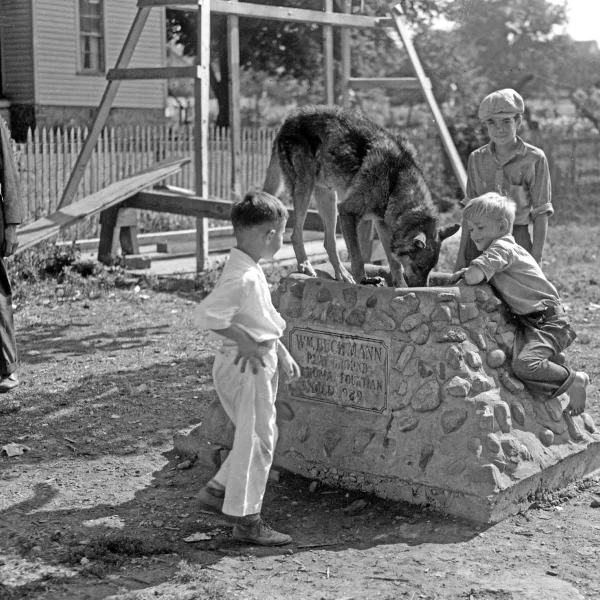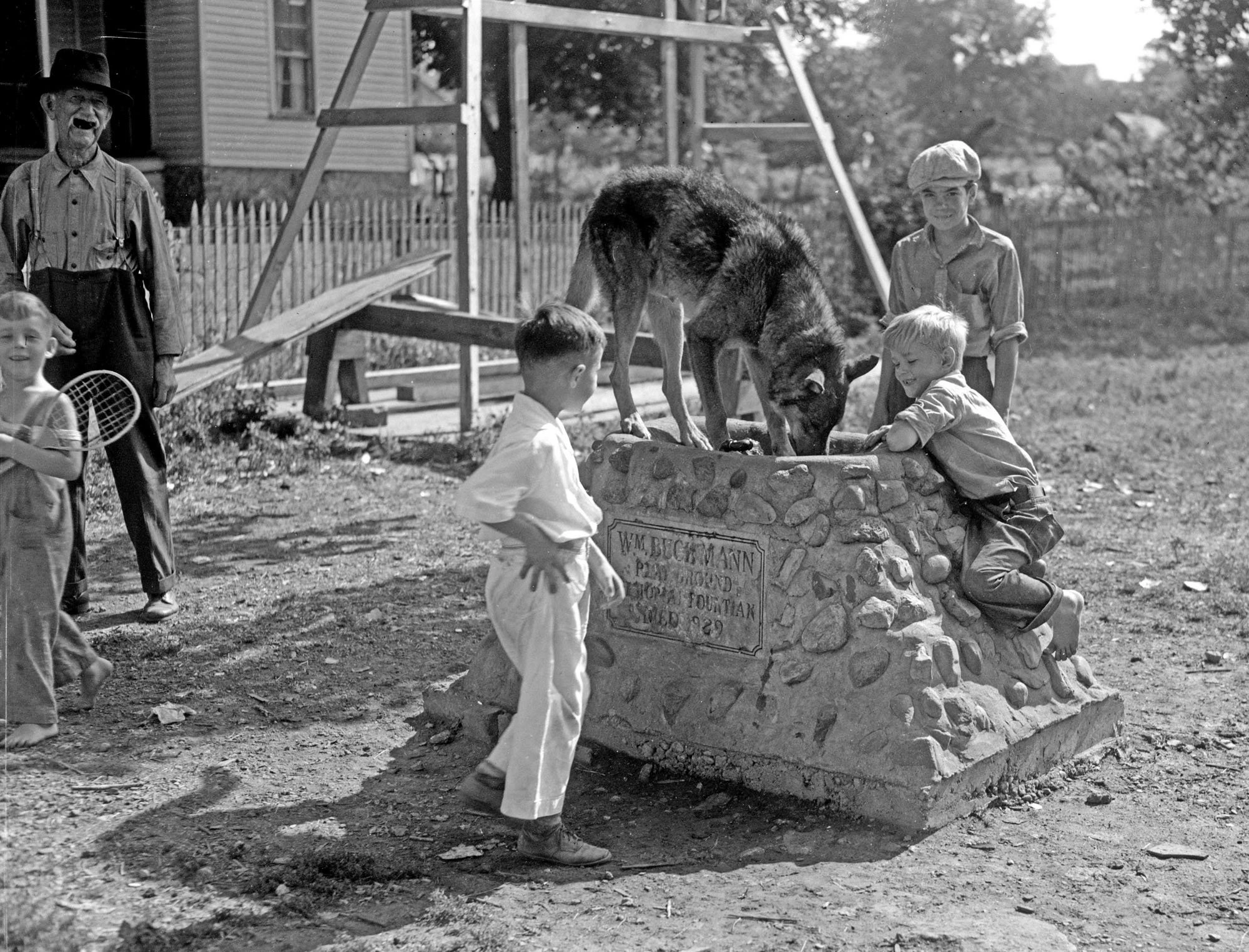Tucked away on Bloomington’s far west side, Buck Mann Park is one of the lovelier, out-of-the-way corners in all the Twin Cities.
Located on Weldon Street in Stevensonville, a historic working-class neighborhood, the park’s namesake is William “Buck” Mann, a coal miner, railroad brakeman and later alderman who in the late 1920s led the charge to open a playground in this long-underserved part of the city. As a voice for the west side, he earned a reputation “for his impulsive advocation of measures for the common people and his love of children.”
Born in Bloomington in 1878, Mann grew up on the west side in a working-class family. As a boy, he got his first job as a caller for the Chicago and Alton (C&A) Railroad Shops. “Before the days of telephones, a call boy’s job was to roust train crews and let them know when their next run would be,” explains local historian and community leader Mike Matejka. “This included rapping on bedroom windows in the middle of the night, or tracking down trainmen at restaurants, poker games or taverns.”
While still a teenager, Mann began working in the local mines, mostly with the McLean County Coal Co., located off West Washington Street just west of the C&A tracks (now Union Pacific and Amtrak). After seven years in the mines and sustaining a broken hip, among other related workplace injuries, he put in another seven with the C&A as a brakeman.
In the steam-powered Industrial Age there were few jobs as dangerous as coal miner, though railroad brakeman was surely one of them. In 1914, Mann was seriously injured in Lawndale, Logan County, when he lost his balance stepping off a lurching railcar and was thrown between the tracks. “Since that time,” related The Pantagraph years later, “he had sought relief by many treatments and operations for severe pain in the head.”
He eventually tired of life as an industrial wage earner, leaving that world behind for the relative peace and quiet of one as a neighborhood grocer. His residence and grocery store were located on the 1400 block of West Oakland Avenue, a stone’s throw away from both where he grew up and the future park he would help build.
In 1926, after running and losing three times for alderman, Mann finally won a seat on the city council. He was reelected to a second term in 1928 (today, Ward 6, minus downtown, mirrors much of Mann’s old Ward 7.)
“When he first was elected he demanded that the Seventh Ward be given equal consideration with all other wards in improvements and representations,” noted The Pantagraph.
Into the 1920s, there were no paved city streets west of the C&A tracks, though by the end of the decade, a stretch of West Olive Street had been paved, and a few side streets graveled. Much of Stevensonville, and all of the Sunnyside addition, were not connected to city sewers until the late 1920s or early 1930s. Prior to that, the area relied on the Bloomington’s last open sewer, which ran straight into Sugar Creek.
Furthermore, the children of Stevensonville and the surrounding residential area, including Sunnyside, had no park or playground to call their own.
In the spring of 1928, Mann helped organize the Seventh Ward Playground Association, which led the charge to transform a privately owned, 90 by 240 foot vacant lot on Weldon Street into a neighborhood park. The association, working with the landowners George Baum and Allie Peterson, agreed to pay the property taxes until enough money had been raised to purchase the grounds outright.
The lot, an uneven, junk-strewn thicket of weeds and box elder saplings three to 15 feet tall, looked like anything but a safe and welcoming space for children.
That began to change the evening of Thursday, Jun. 21, 1928, when Mann, armed with a meat clever from is grocery store, began attacking the “wilderness of bramble bushes.” The alderman was soon joined by a large group of volunteers, including Weldon Street residents James Daley, a railroad switchman; Frank Erdman, a laborer; Louis Gottschalk, who shoveled coal for Illinois Power and Light Co.; Arthur Johnson, a machine operator with Meadows Manufacturing; and others.
“Men who had worked all day at many trades turned out en masse to make a playground,” reported The Pantagraph several days later. “They returned Friday night. They returned Saturday night. Sunday, the plat was cleared, the ground was partly leveled. The weeds were gone and the beginning of the ‘Seventh Ward Playground’ was well underway.”
Merle Butler, who lived on the 1300 block of West Jackson Street, donated a scraper, plow, harrow and disc, and a team of work horses. Clarence Dalton hauled away more than 40 loads of rubbish in his garbage wagon.
Funds were raised by knocking on doors and soliciting pledges. “It was not an easy task to raise that sum among residents of the vicinity, who were mostly wage earners,” remarked The Pantagraph. There were also several fundraisers, including a community carnival, a supper, which drew 370 people, and two dances, though only the second one made money.
Some playground equipment was made by local residents in their workshops or garages, and soon enough the park featured “a six-rack swing, horseshoe courts, baseball diamond, merry-go-round and other devices.” The city donated lights and agreed to pipe in water.
Sadly, Mann did not live to see his vision come to full fruition. He passed away on Jul. 24, 1929, at the age of 51. “His illness was of long-standing,” recalled The Pantagraph, referring to his injuries sustained as a coal miner and railroad brakeman.
Five days after Mann’s death, members of the playground association gathered under the park’s lights and decided to rename the grounds for “Buck” Mann. It was also agreed to construct a memorial fountain in his honor (see accompanying photograph), and to fly the park’s flag at half mast every Jul. 24 to mark his passing.
At the time of Mann’s death, the association was nearing its fundraising goal, and shortly thereafter the sale of the playground lot was finalized and the deeds transferred. In November 1929, the neighborhood group reported $3,205 in receipts and $2,369.95 in expenditures, with most of the latter going to the lot’s purchase.
Eight years later, in the summer of 1937, the Buck Mann Playground Association offered its grounds to the city, and today, the handsome municipal park features a basketball court, playground equipment and a ball field.
Due to its out-of-the-way location and the regrettable west side bias harbored by too many Twin City residents, Buck Mann Park remains one of the community’s hidden gems.
“Our changing the [park’s] name is the least we can do for Buck,” Harry Ekstam, president of the playground association, said back in the summer of 1929. “Possibly the idea of Seventh Ward has been emphasized too much. All children are welcome here. This is not limited to one ward. Buck always said that. By giving the grounds his name we will be keeping alive his ideal to have a place for all.”

